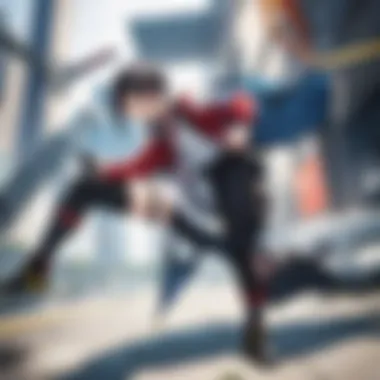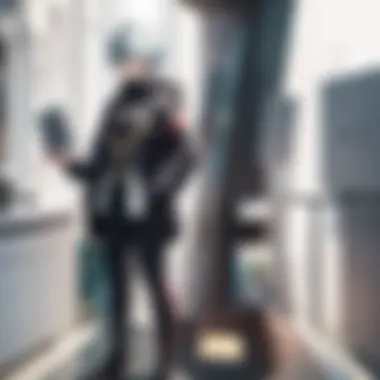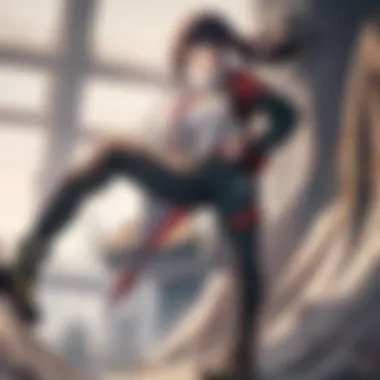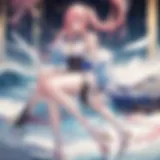Unraveling the My Hero Academia Manga Volumes: A Comprehensive Exploration


Introduction to the Series
My Hero Academia, a popular manga and anime series, has captivated audiences worldwide with its engaging storyline and dynamic characters. Debuting in Japan in 2014, the series falls within the action, superpower, and school life genres, attracting a diverse fan base across different age groups. Created by the talented Kohei Horikoshi, My Hero Academia follows the journey of Izuku Midoriya, a Quirkless boy aspiring to become a hero in a world where superpowers, known as Quirks, are the norm. The series has garnered immense popularity for its unique take on heroism and coming-of-age themes, resonating with fans globally.
Plot Summary and Analysis
In My Hero Academia, the narrative unfolds in a society where individuals with Quirks attend U.A. High School to hone their abilities and become professional heroes. The series explores various story arcs, from fierce battles against villains to heartwarming moments of camaraderie among classmates. Key characters like Izuku Midoriya, Katsuki Bakugo, and Ochaco Uraraka undergo significant growth throughout the series, grappling with personal challenges and moral dilemmas. The plot intertwines action-packed scenes with introspective narratives, delving deep into the complexities of heroism and sacrifice. Horikoshi's storytelling weaves together themes of friendship, perseverance, and self-discovery, enriching the overarching narrative with emotional depth and thematic richness.
Reception and Impact
Critically acclaimed and beloved by fans, My Hero Academia has received praise for its compelling storyline, well-developed characters, and intricate world-building. Critics have commended the series for its engaging plot twists, nuanced character relationships, and thought-provoking exploration of hero society. With a dedicated fan base and numerous accolades, including awards for its exceptional animation and voice acting, My Hero Academia has left a lasting impact on the anime and manga landscape. Its popularity extends beyond entertainment, sparking discussions on heroism, identity, and societal values. As a standout work in the shonen genre, My Hero Academia continues to attract new audiences and inspire passionate discussions within the anime community.
Introduction
In this section, we embark on a journey delving into the intricacies of My Hero Academia manga volumes. The significance of this topic lies in unravelling the layers of characters, plots, and artistry within this renowned series, offering readers a comprehensive insight into the world crafted by Kohei Horikoshi. By exploring this subject, readers can immerse themselves in a narrative that transcends traditional storytelling boundaries and captivates with its depth and complexity.
Brief Overview of My Hero Academia
Origins of the series
Unveiling the origins of My Hero Academia sheds light on the evolution of this iconic series. The inception of the manga represents a pivotal moment in the realm of anime and manga, revolutionizing the superhero genre with its fresh perspective and dynamic characters. The blend of traditional superhero elements with Japanese cultural influences sets My Hero Academia apart, attracting a global audience seeking innovative narratives and diverse representation. The unique fusion of heroism and personal growth resonates with readers, making the series a compelling choice for enthusiasts exploring complex themes and intricate character arcs.
Popularity and global impact


The meteoric rise of My Hero Academia to global acclaim reflects its profound impact on popular culture and storytelling conventions. The series' popularity transcends borders, captivating fans worldwide with its relatable characters, compelling narratives, and visually stunning artwork. Its success not only signifies a shift in audience preferences towards emotionally resonant tales but also demonstrates the universal appeal of heroism and resilience depicted in the manga. The widespread recognition of My Hero Academia underscores its ability to engage diverse audiences and inspire discussions on morality, society, and the essence of heroism, enriching the reading experience for fans seeking intellectual stimulation and emotional depth.
Character Analysis
Character analysis plays a pivotal role in our exploration of My Hero Academia manga volumes. By delving deep into the intricacies of each character, we unravel the layers of complexity and depth that contribute to the richness of the series. Understanding the protagonists and antagonists on a profound level enhances our appreciation for the storytelling and the underlying themes woven throughout the narrative. Character analysis helps us discern the growth, motivations, and inner conflicts of the characters, shedding light on their significance in shaping the evolving plot and relationships within the My Hero Academia universe.
Protagonists
In the realm of My Hero Academia, the protagonists stand as beacons of hope and determination, navigating a world teeming with challenges and adversities. From the resilient Deku striving to fulfill his dreams against all odds to the fiery Katsuki exhibiting raw power and tenacity, each protagonist brings a distinct flavor to the storyline. Exploring the protagonists allows us to witness their evolution, from humble beginnings to remarkable achievements, offering insights into their character development, strengths, and vulnerabilities. Through their distinct personalities and backgrounds, the protagonists carve a path of inspiration and growth, resonating with readers on a profound level.
Antagonists
Contrasting the protagonists are the formidable antagonists who add a layer of complexity and conflict to the narrative. Antagonists such as the enigmatic Shigaraki and the calculating All For One bring forth challenges that test the resilience and convictions of the heroes. By delving into the motivations and intricacies of the antagonists, we unravel the darker shades of the My Hero Academia world, exploring themes of power, ambition, and morality. Understanding the antagonists provides a holistic view of the conflicts driving the storyline, as they serve as formidable obstacles that push the protagonists to their limits and force them to confront their beliefs and values.
Plot Examination
Major Story Arcs
Within the realm of My Hero Academia, the Major Story Arcs play a pivotal role in shaping the trajectory of the narrative. Each arc introduces new challenges, conflicts, and developments that push the characters to their limits and drive the overarching plot forward. From the exhilarating U.A. Sports Festival Arc to the intense Hideout Raid Arc, every major arc contributes to the growth and evolution of the protagonist, Izuku Midoriya, and his peers. These story arcs not only provide action-packed sequences but also delve deeply into the moral dilemmas, personal struggles, and emotional turmoils faced by the characters, adding layers of complexity to the My Hero Academia storyline.
Themes and Symbolism
The exploration of Themes and Symbolism in My Hero Academia transcends beyond surface-level storytelling, delving into the deeper layers of societal reflections and philosophical musings. Themes such as heroism, friendship, perseverance, and sacrifice resonate throughout the series, sparking introspection and contemplation among readers. The symbolic representations woven into the narrative, from All Might's iconic symbol of peace to the contrasting ideals of heroes and villains, add richness and depth to the storytelling. By critically examining the themes and symbolism present in My Hero Academia, readers can uncover hidden meanings, profound messages, and thought-provoking commentary on real-world issues, making the manga not just a tale of superheroes but a reflective mirror of our own society.
Illustrative Artwork


In the realm of manga, illustrative artwork plays a pivotal role in engaging readers and bringing the narrative to life. The significance of illustrative artwork in the context of My Hero Academia manga volumes cannot be overstated. Each intricate illustration serves as a visual representation of the characters, their emotions, and the dynamic hero-filled world they inhabit. The artwork in My Hero Academia not only complements the storytelling but also enhances the overall reading experience, captivating fans and immersing them in the visually stunning universe crafted by the talented creator, Kohei Horikoshi.
Illustrative artwork serves as more than just aesthetically pleasing images; it is a window into the souls of the characters, conveying subtle emotions and intricate details that words alone may fail to capture. The meticulous attention to detail in each artwork piece, from character designs to action sequences, showcases Horikoshi's dedication to bringing his vision to life on the pages of the manga. Furthermore, the vivid and dynamic nature of the illustrative artwork in My Hero Academia not only adds visual flair but also serves as a key element in establishing the iconic visual style of the series.
Visual Style and Evolution
The visual style of My Hero Academia has undergone a fascinating evolution since its inception, mirroring the growth and development of both the characters and the overarching narrative. At the outset, the art style exuded a sense of energy and vibrancy, perfectly reflecting the dynamic nature of the hero-centric storyline. As the series progressed, notable changes in the artwork emerged, showcasing Horikoshi's refined skills and his ability to experiment with different artistic techniques.
One of the most captivating aspects of the visual evolution in My Hero Academia is the meticulous attention given to character designs and backgrounds. The evolution of character appearances over time not only mirrors their personal growth but also underscores the evolving themes and tone of the storyline. Additionally, the shift in visual style from initial volumes to more recent ones highlights Horikoshi's willingness to push boundaries and continually enhance the visual storytelling aspect of the series.
From dynamic action sequences to poignant character moments, the visual style of My Hero Academia has played a crucial role in captivating audiences and immersing them in the intricate hero-filled world. The evolution of the artwork not only serves as a testament to Horikoshi's growth as an artist but also adds an extra layer of depth and richness to the already captivating narrative woven throughout the manga series.
Fan Community Impact
In the realm of My Hero Academia Manga Volumes, the Fan Community Impact plays a pivotal role in shaping the overall experience and enjoyment of enthusiasts. The passionate fan base contributes to vibrant discussions, creative theories, and a sense of community that enriches the reader's connection to the series. By engaging with fellow fans, individuals can delve deeper into the intricate layers of the storyline, character development, and thematic elements present in the manga.
Discussions and Theories
Fan interpretations:
Fan interpretations within the My Hero Academia community offer a fascinating insight into how readers perceive and analyze the characters, events, and underlying messages of the series. These interpretations spark lively debates, encourage critical thinking, and provide different perspectives on the narrative. By dissecting and interpreting various aspects of the manga, fans can develop a deeper appreciation for the story's complexities and resonate with its themes on a personal level.
Speculative threads:


Speculative threads serve as an avenue for fans to explore hypothetical scenarios, potential plot developments, and unanswered questions within the My Hero Academia universe. These threads fuel creativity, inspire fan-generated content, and keep the excitement alive between manga releases. While speculative threads may sometimes veer into conjecture, they stimulate imagination and foster a sense of anticipation among readers, driving continuous engagement with the series.
Critical Reception
In exploring the realm of My Hero Academia manga volumes, critical reception stands as a paramount aspect not merely for validation but as a barometer of its impact on the anime and manga sphere. The recognition and evaluation from critics and scholars provide a lens through which we can gauge the series' artistic merit and cultural significance. Delving into critical reception allows enthusiasts to comprehend the broader discourse surrounding My Hero Academia, offering profound insights into its thematic depth, character development, and narrative intricacies. Examining the intersection of art and critique illuminates the nuances of Kohei Horikoshi's creation, shedding light on its evolving nature and resonating themes within the genre.
Professional Reviews
Professional reviews serve as a cornerstone in shaping the intellectual landscape of My Hero Academia manga volumes. These critiques penned by industry experts and seasoned analysts offer a meticulous examination of various facets ranging from plot coherence, character dynamics, artistic prowess, to underlying philosophical and social commentaries. Engaging with professional reviews unveils a scholarly dimension to the fandom, enriching the discourse with erudite perspectives and detailed elucidations. Each review acts as a gateway to comprehending the series from a nuanced viewpoint, encouraging readers to appreciate the depth and complexity of Horikoshi's narrative craftsmanship.
Reader Feedback
Beyond the realm of professional critiques lies the invaluable realm of reader feedback, constituting the pulse of the manga community. Reader feedback plays a pivotal role in sculpting the collective understanding and appreciation of My Hero Academia, reflecting the diverse interpretations and emotional resonance it evokes among fans. Engaging with reader feedback unveils a tapestry of personal anecdotes, resonant experiences, and fan theories that enrich the narrative tapestry woven by Horikoshi. Through the lens of reader feedback, enthusiasts not only gain insight into the series' impact on individual readers but also witness the communal spirit that binds fans together in a shared love for this captivating universe.
Legacy and Future Prospects
As we peer into the legacy aspect, it becomes evident that the influence of My Hero Academia extends far beyond the realm of manga and anime. The series has carved a notable niche for itself by redefining traditional hero narratives and exploring complex themes such as heroism, society, and identity. By analyzing the impact of My Hero Academia on the wider cultural landscape, we can appreciate how it has spurred conversations and inspired a new wave of storytelling within the genre.
Furthermore, delving into the future prospects of My Hero Academia unravels a tapestry of possibilities and expectations. As the series continues to evolve and weave intricate plotlines, fans are left speculating about the direction it will take. Will new characters emerge? What thematic explorations lie ahead? By pondering these questions, we can tap into the essence of anticipation and excitement that accompanies the future evolution of a beloved series.
Crucial to considering the legacy and future prospects of My Hero Academia is acknowledging its potential to shape the trajectory of the genre itself. By pushing boundaries, introducing innovative storytelling techniques, and captivating audiences worldwide, My Hero Academia has set a benchmark for excellence within the contemporary manga landscape. Embracing the legacy and pondering the future prospects of this series allows enthusiasts to partake in a dynamic dialogue that transcends the confines of traditional fandom.
Influence on the Genre
In examining the profound influence of My Hero Academia on the wider manga genre, we are confronted with a tale of innovation, resonance, and inspiration. Kohei Horikoshi's creation has left an indelible mark on the genre, reshaping conventional norms and challenging established tropes with its refreshing narrative approach and thematic depth.
At the core of My Hero Academia's influence lies its unique ability to subvert genre expectations while staying true to the essence of traditional hero narratives. By imbuing the series with intricate character developments, morally nuanced plotlines, and thought-provoking social commentary, Horikoshi has elevated the shonen genre to new heights, captivating audiences of all ages and backgrounds.
Moreover, the thematic richness of My Hero Academia has sparked a wave of creativity and introspection within the manga community. From exploring the nature of heroism and sacrifice to delving into the complexities of power and responsibility, the series stands as a testament to the enduring power of storytelling as a catalyst for change and reflection.
As fans immerse themselves in the captivating world of My Hero Academia, they are not merely passive observers but active participants in a cultural phenomenon that continues to shape and redefine the contours of the manga genre. Through its profound influence on storytelling conventions, character dynamics, and thematic explorations, My Hero Academia stands as a beacon of inspiration for aspiring manga creators and avid enthusiasts alike.













